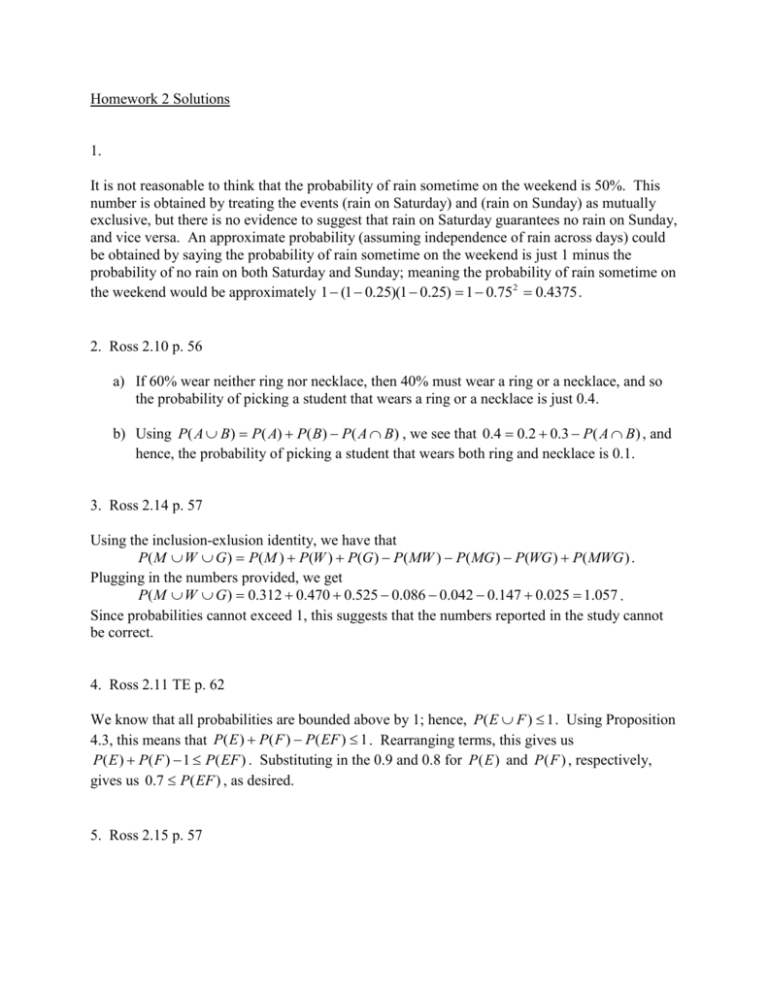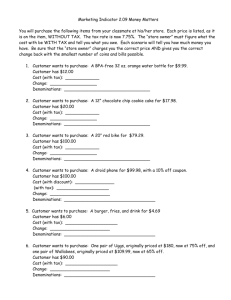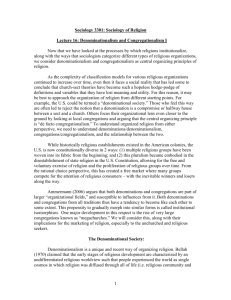Homework 2 Solutions
advertisement

Homework 2 Solutions 1. It is not reasonable to think that the probability of rain sometime on the weekend is 50%. This number is obtained by treating the events (rain on Saturday) and (rain on Sunday) as mutually exclusive, but there is no evidence to suggest that rain on Saturday guarantees no rain on Sunday, and vice versa. An approximate probability (assuming independence of rain across days) could be obtained by saying the probability of rain sometime on the weekend is just 1 minus the probability of no rain on both Saturday and Sunday; meaning the probability of rain sometime on the weekend would be approximately 1 (1 0.25)(1 0.25) 1 0.75 2 0.4375 . 2. Ross 2.10 p. 56 a) If 60% wear neither ring nor necklace, then 40% must wear a ring or a necklace, and so the probability of picking a student that wears a ring or a necklace is just 0.4. b) Using P( A B) P( A) P( B) P( A B) , we see that 0.4 0.2 0.3 P( A B) , and hence, the probability of picking a student that wears both ring and necklace is 0.1. 3. Ross 2.14 p. 57 Using the inclusion-exlusion identity, we have that P( M W G ) P( M ) P(W ) P(G ) P( MW ) P( MG ) P(WG ) P( MWG ) . Plugging in the numbers provided, we get P( M W G ) 0.312 0.470 0.525 0.086 0.042 0.147 0.025 1.057 . Since probabilities cannot exceed 1, this suggests that the numbers reported in the study cannot be correct. 4. Ross 2.11 TE p. 62 We know that all probabilities are bounded above by 1; hence, P( E F ) 1 . Using Proposition 4.3, this means that P( E ) P( F ) P( EF ) 1 . Rearranging terms, this gives us P( E ) P( F ) 1 P( EF ) . Substituting in the 0.9 and 0.8 for P (E ) and P (F ) , respectively, gives us 0.7 P( EF ) , as desired. 5. Ross 2.15 p. 57 13 a) There are different ways to draw a flush from a single suit; since there are 4 suits, 5 13 52 the probability of a flush is 4 0.0020 . 5 5 b) From any of the 13 denominations, pick 2 out of 4 cards; then pick 3 of the remaining 12 denominations, and take 1 card apiece from each; i.e., the probability of getting one pair 4 12 4 4 4 52 is 13 0.4226 . 2 3 1 1 1 5 c) Pick 2 out of the 13 denominations, and pick 2 out of 4 cards from each of those. Then pick one card from the remaining 44 cards; so the probability of getting two pairs is 13 4 4 44 52 0.0475 . 2 2 2 1 5 d) To get 3 of a kind, from any of the 13 denominations, pick 3 out of 4 cards, then pick 2 of the remaining 12 denominations and grab 1 card apiece from each. Hence, the 4 12 4 4 52 probability of obtaining 3 of a kind is 13 0.0211 . 3 2 1 1 5 e) To get 4 of a kind, from any of the 13 denominations, grab all 4 cards, then pick 1 of the 4 48 52 remaining 48 cards in the deck: 13 0.0002 . 4 1 5 6. Ross 2.28 p. 58 a) The probability of getting all 3 balls to be the same color is just 5 6 8 3 3 3 86 P( same) 969 19 3 b) The probability of getting all 3 balls to be different color is 5 6 8 1 1 1 240 80 P(different ) 969 323 19 3 If sampling is done with replacement, then we instead get as the probability of all balls being the same and all balls being different: 53 6 3 83 853 P( same) P( RRR ) P( BBB ) P(GGG) 3 6859 19 6 5 6 8 1440 P(diff ) P( RBG ) P( RGB ) P( BRG ) P( BGR ) P(GRB ) P(GBR ) 6859 19 3 7. Ross 2.37 p. 59 a) Since all selections of 5 problems are equally likely, the probability that the student answers all 5 problems correctly is just the # of ways 5 problems can be chosen from the 7 the student knows how to do divided by the total # of ways 5 problems can be chosen from a set of 10, so 7 10 1 P(all 5 correct ) . 5 5 12 b) The probability that the student gets at least 4 of the problems correct is just the probability of the student getting exactly 4 correct plus the probability of getting all 5 correct. To get 4 correct, 4 out of the 7 the student knows must be chosen as well as 1 out of the 3 he doesn’t know, so 7 3 10 105 5 P(exactly 4 correct ) , 4 1 5 252 12 which means that the probability of getting at least 4 correct would be 5 1 1 P(at least 4 correct ) . 12 12 2 8. Ross 2.52 p. 60 a) We can obtain this probability by determining how many different ways one can choose 8 out of the 10 pairs of shoes and then 1 of the 2 shoes for each of the selected pairs, and then dividing this figure by the total number of ways one can choose 8 shoes from a set of 20; in other words, we have 10 8 2 8 20 18 16 14 12 10 8 6 P(no pairs ) 0.0915 20 19 18 17 16 15 14 13 20 8 b) This probability can be obtained by considering how many different ways one can choose 1 out of the 10 pairs of shoes (grabbing both shoes from that pair) and then follow that up by choosing 6 of the remaining 9 pairs of shoes (grabbing 1 of the 2 shoes for each of these pairs), and again divide by the total number of ways one can choose 8 shoes from a set of 20; i.e., the probability of choosing exactly one pair is 10 9 6 2 1 6 10 84 64 P(exactly 1 pair ) 0.4268 . 125970 20 8








